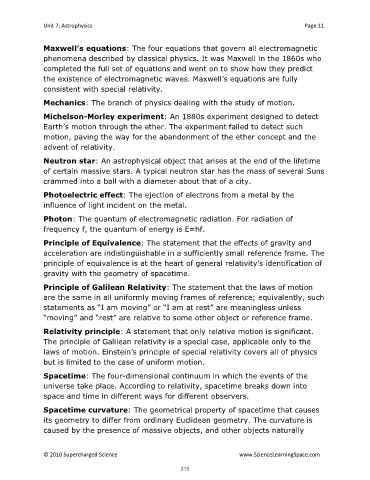Page 213 - Microsoft Word - LessonPlan-Overview.doc
P. 213
Unit 7: Astrophysics Page 11
Maxwell’s equations: The four equations that govern all electromagnetic
phenomena described by classical physics. It was Maxwell in the 1860s who
completed the full set of equations and went on to show how they predict
the existence of electromagnetic waves. Maxwell’s equations are fully
consistent with special relativity.
Mechanics: The branch of physics dealing with the study of motion.
Michelson-Morley experiment: An 1880s experiment designed to detect
Earth’s motion through the ether. The experiment failed to detect such
motion, paving the way for the abandonment of the ether concept and the
advent of relativity.
Neutron star: An astrophysical object that arises at the end of the lifetime
of certain massive stars. A typical neutron star has the mass of several Suns
crammed into a ball with a diameter about that of a city.
Photoelectric effect: The ejection of electrons from a metal by the
influence of light incident on the metal.
Photon: The quantum of electromagnetic radiation. For radiation of
frequency f, the quantum of energy is E=hf.
Principle of Equivalence: The statement that the effects of gravity and
acceleration are indistinguishable in a sufficiently small reference frame. The
principle of equivalence is at the heart of general relativity’s identification of
gravity with the geometry of spacetime.
Principle of Galilean Relativity: The statement that the laws of motion
are the same in all uniformly moving frames of reference; equivalently, such
statements as “I am moving” or “I am at rest” are meaningless unless
“moving” and “rest” are relative to some other object or reference frame.
Relativity principle: A statement that only relative motion is significant.
The principle of Galilean relativity is a special case, applicable only to the
laws of motion. Einstein’s principle of special relativity covers all of physics
but is limited to the case of uniform motion.
Spacetime: The four-dimensional continuum in which the events of the
universe take place. According to relativity, spacetime breaks down into
space and time in different ways for different observers.
Spacetime curvature: The geometrical property of spacetime that causes
its geometry to differ from ordinary Euclidean geometry. The curvature is
caused by the presence of massive objects, and other objects naturally
© 2010 Supercharged Science www.ScienceLearningSpace.com
213

